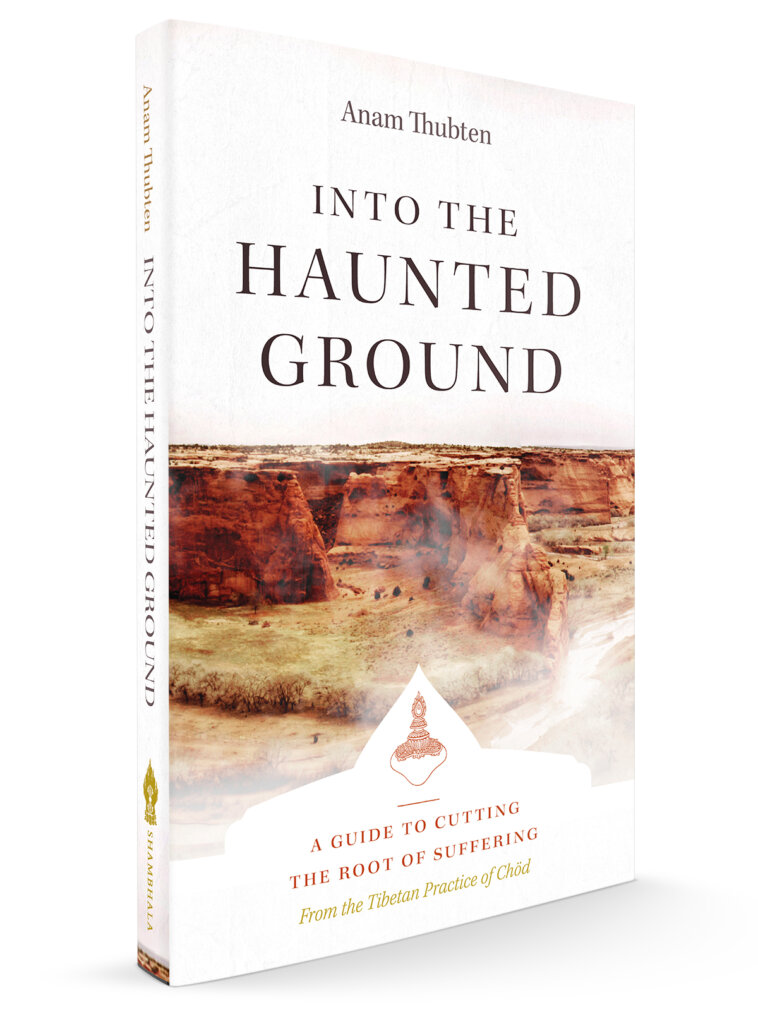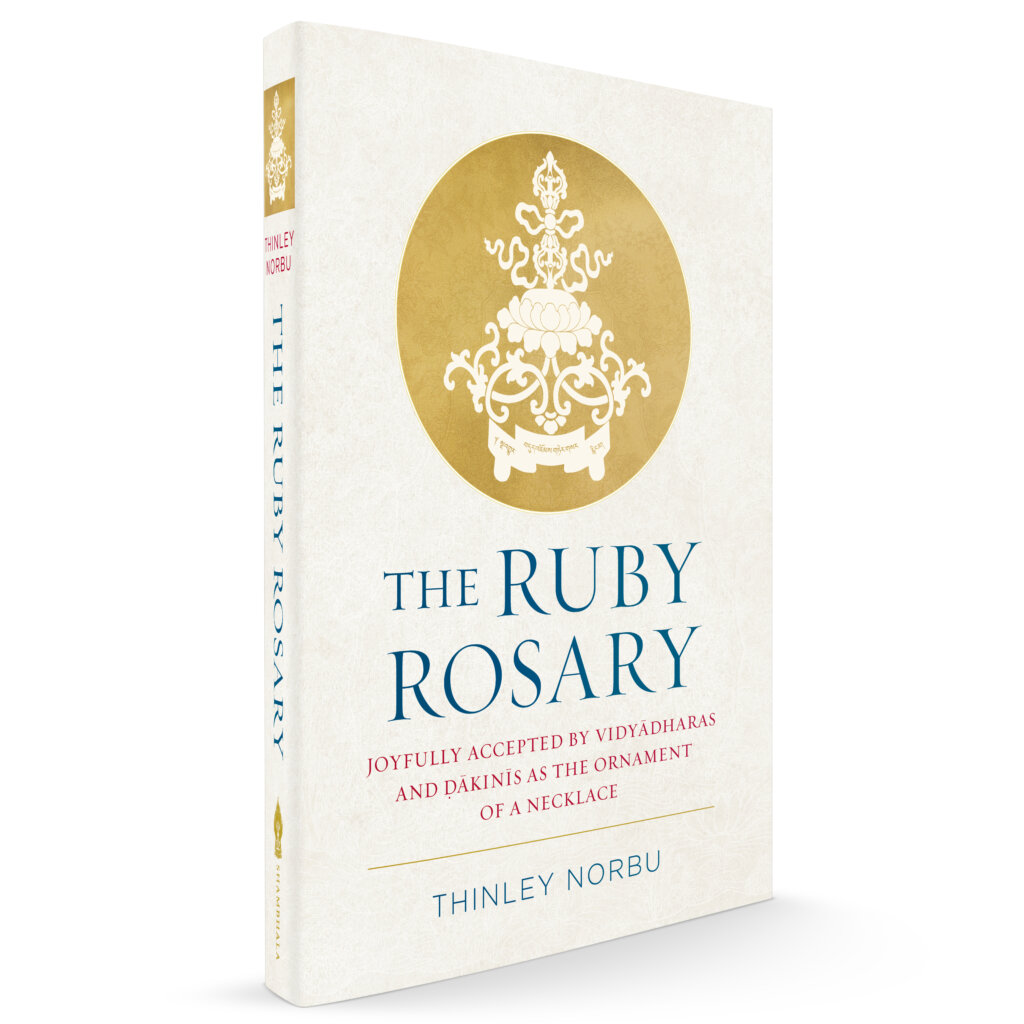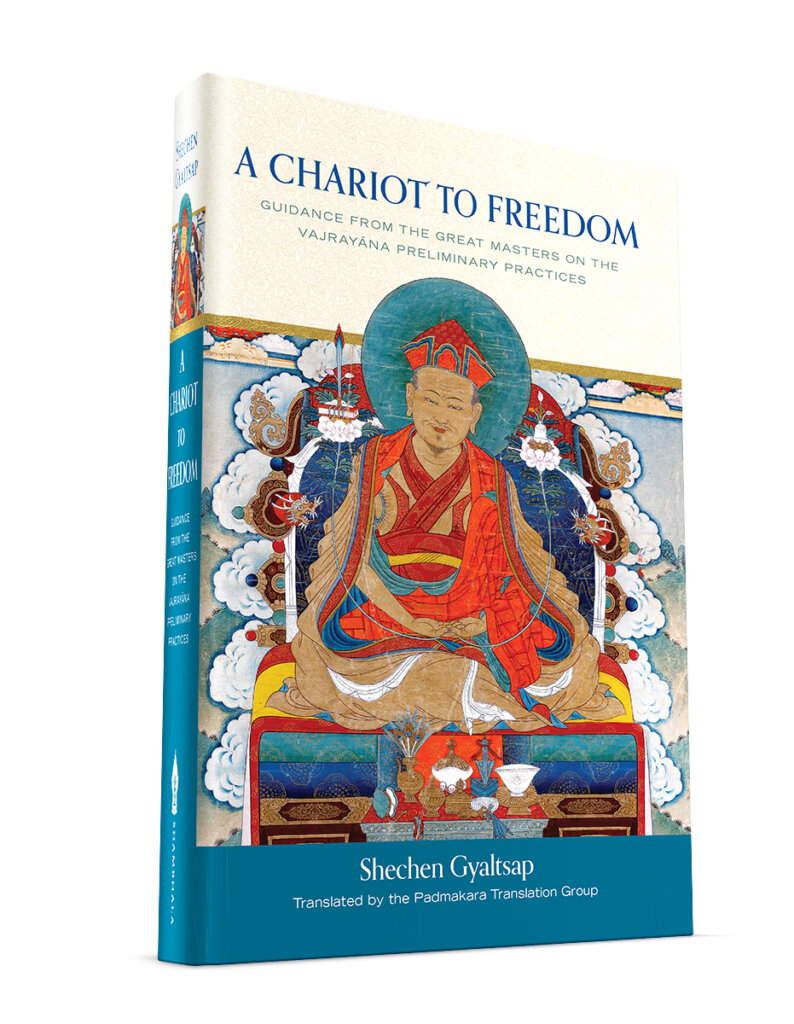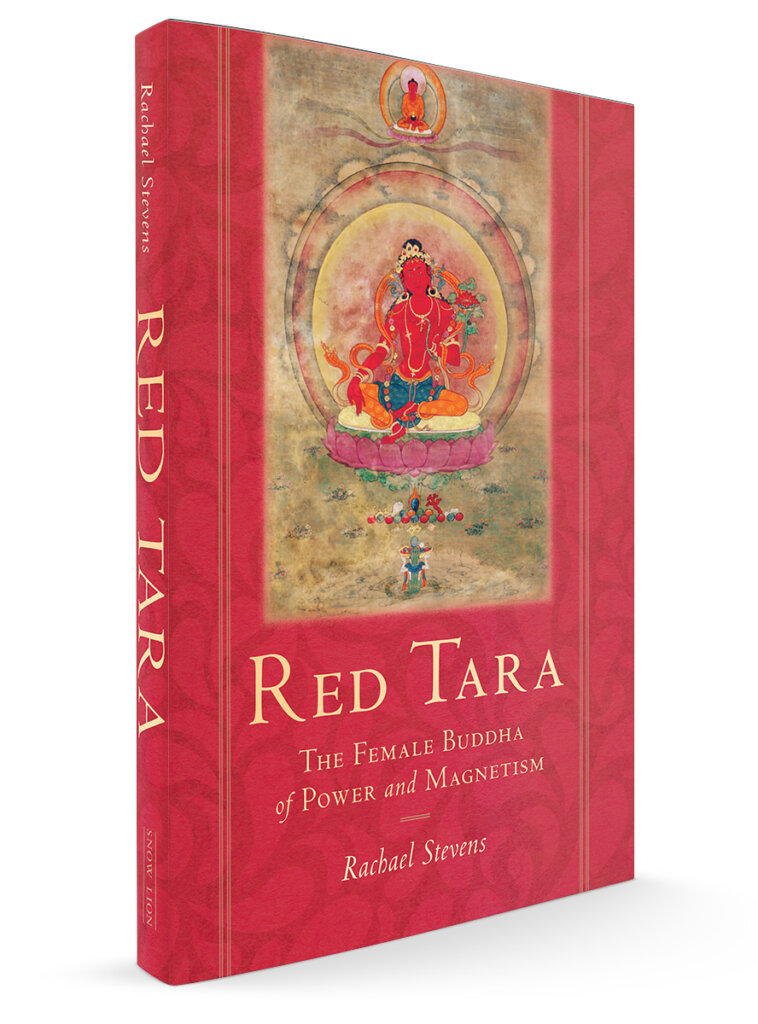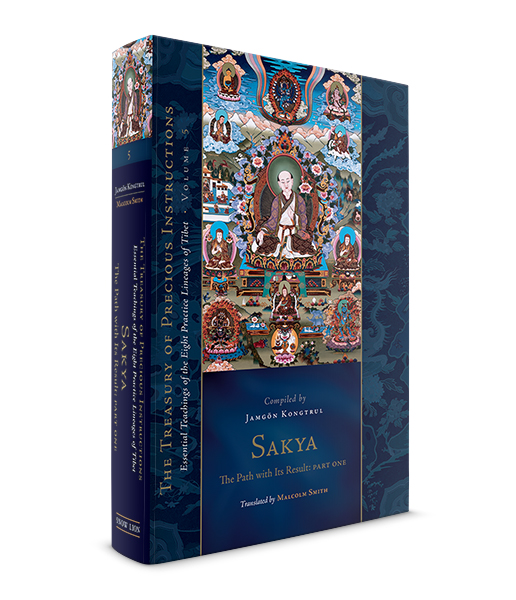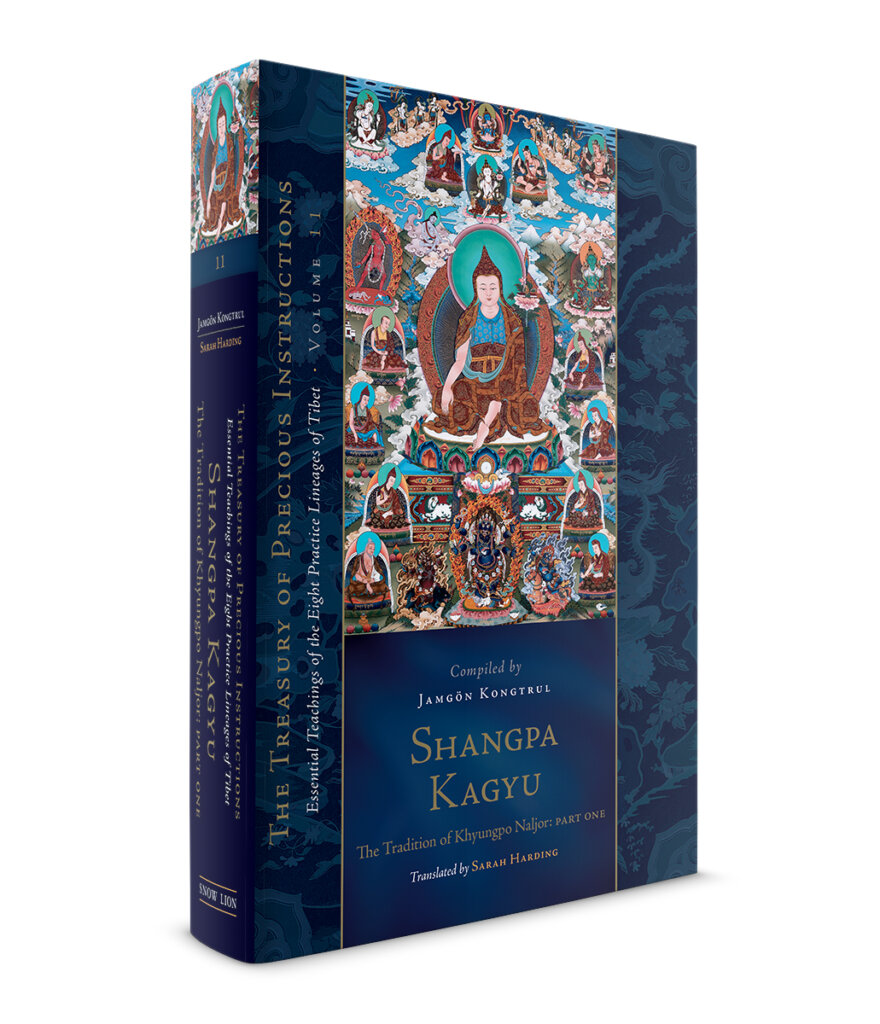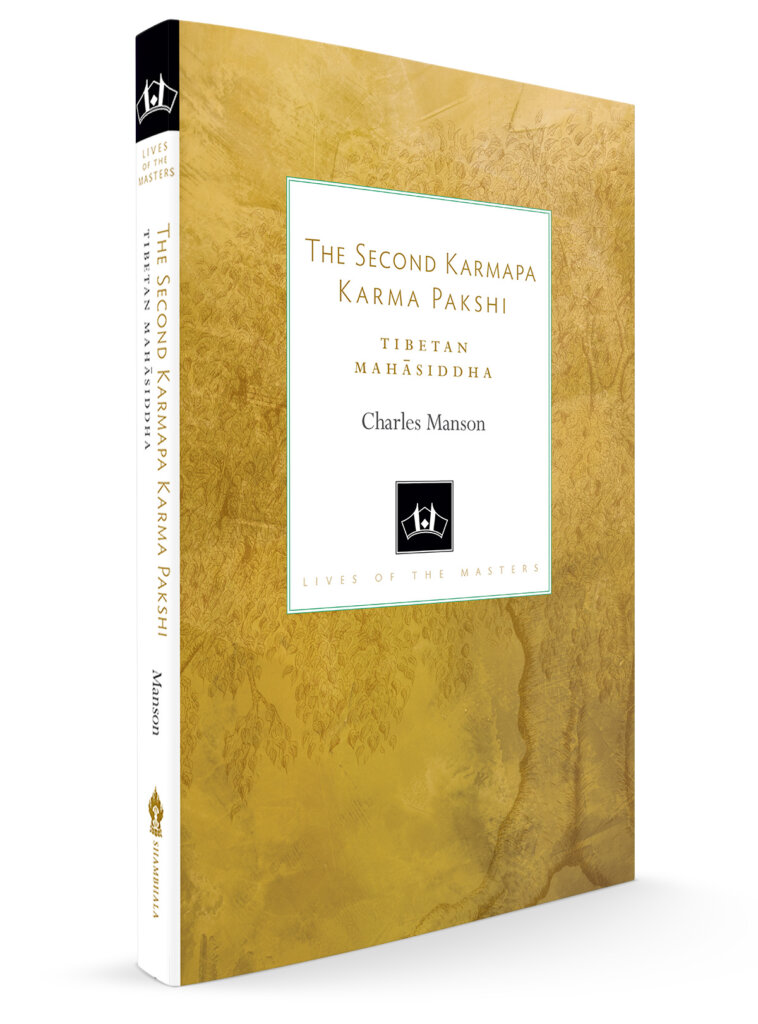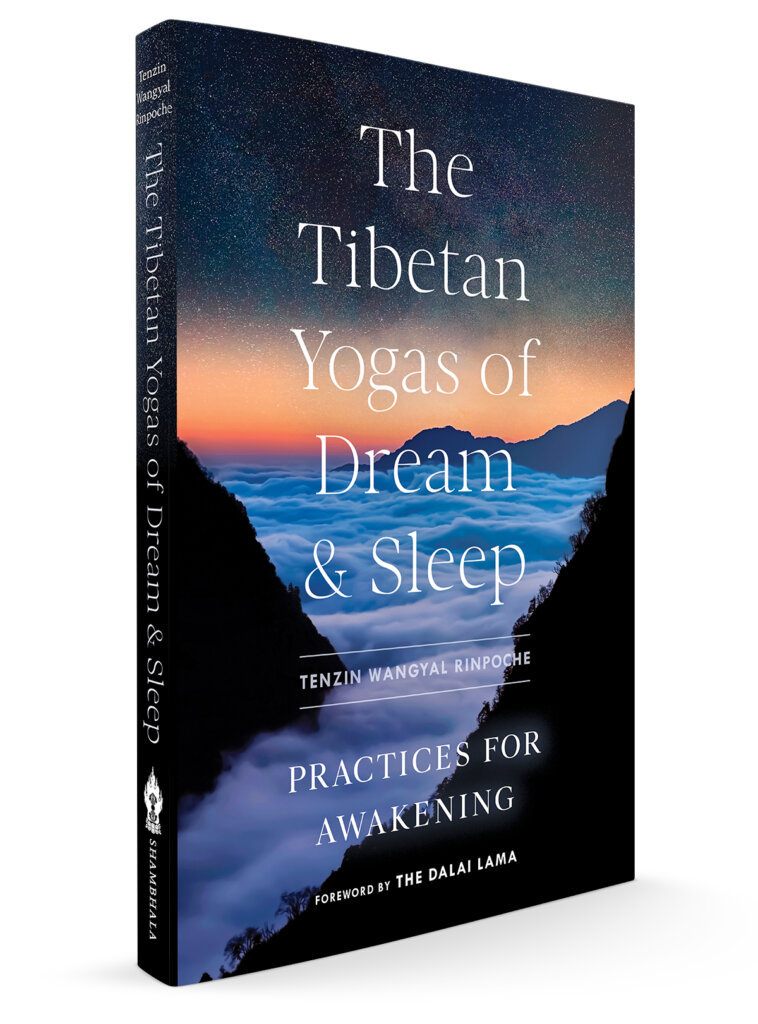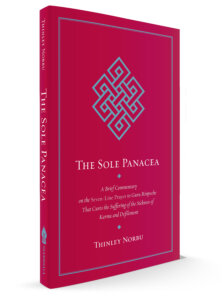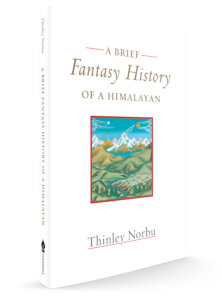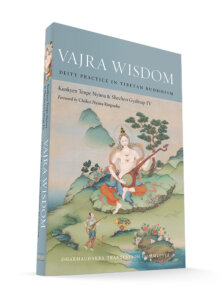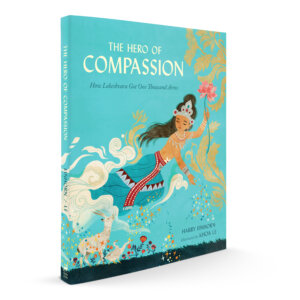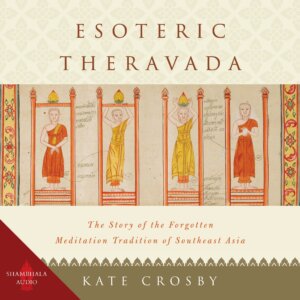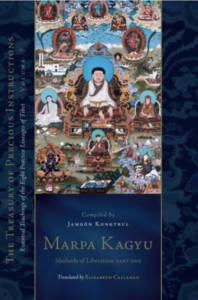See our other Year in Review Guides:
Theravada/Pali/Insight | Zen and Chan | Tibetan Buddhism
Yoga | Personal Development | Kids Books
We are very happy to share with you a look back at our 2022 books for those who practice in the Tibetan tradition.
Jump to: Reader Guides | Books | Books for Kids | Audiobooks | Forthcoming Books
How We Live Is How We Die
By Pema Chodron
In How We Live Is How We Die, Pema Chödrön shares her wisdom for working with this flow of life—learning to live with ease, joy, and compassion through uncertainty, embracing new beginnings, and ultimately preparing for death with curiosity and openness rather than fear.
Poignant for readers of all ages, her teachings on the bardos—a Tibetan term referring to a state of transition, including what happens between this life and the next—reveal their power and relevance at each moment of our lives. She also offers practical methods for transforming life’s most challenging emotions about change and uncertainty into a path of awakening and love. As she teaches, the more freedom we can find in our hearts and minds as we live this life, the more fearlessly we’ll be able to confront death and what lies beyond. In all, Pema provides readers with a master course in living life fully and compassionately in the shadow of death and change.
The Power of Mind: A Tibetan Monk’s Guide to Finding Freedom in Every Challenge
By Khentrul Lodrö T'hayé Rinpoche
A modern guidebook based on ancient Buddhist techniques for transforming emotional pain, anxiety, and stress into complete mental well-being that benefits us and the people around us.
We’ve all heard platitudes about cultivating love and compassion, but how can we really develop these qualities in ourselves and—crucially—share them in our world? The Power of Mind provides a proven path.
Khentrul Rinpoche teaches that regardless of what’s unfolding in our lives, our route to freedom lies in our minds—and how we work with them. A thousand years ago, the Indian saint Atisha endured great hardship to bring the Buddha’s teachings to Tibet, where they flourished. This book introduces a primary text that emerged—the Seven Key Points of Mind Training.
Khentrul Rinpoche learned these practices from teachers who faced innumerable hardships during the Cultural Revolution. Rinpoche was moved by the ability of these teachers who, like alchemists, were able to follow these techniques to transform their suffering into something good.
The Power of Mind shares instructions that we can work through, one by one—from recognizing the preciousness and impermanence of our lives to avoiding drama and self-centeredness—along with meditations and practices. This wisdom is accessible to anyone seeking inner transformation—whether Buddhist or not. As Khentrul Rinpoche states, “Peace and happiness can be attained, but not by searching for something in the outside world. They start within us then extend out to the entire globe.”
The Heroic Heart: Awakening Unbound Compassion
Just as the archetypal hero possesses the heart to face trials and tribulations for the sake of helping others, the bodhisattva has a remarkable resolve to free others from suffering so that all may achieve true happiness and awakening. Through each challenge, the Buddhist hero of compassion develops rich inner qualities that empower them to be of true benefit to others.
In The Heroic Heart, Jetsunma Tenzin Palmo, an esteemed spiritual teacher with a lifetime of experience, illuminates the heart of Mahayana Buddhism—bodhichitta—describing it as “the selfless expression of boundless compassion.” Jetsunma uses as a touchstone the famous Tibetan Buddhist text The Thirty-Seven Verses on the Practice of a Bodhisattva. Here, she reveals how to become such a compassionate hero, the bodhisattva in training, and helps us to face the uncertain tides of the world, however joyful or dangerous, with a deep wish to find meaning and uncover the ultimate heart of wisdom and compassion.
Awakening Dignity: A Guide to Living a Life of Deep Fulfillment
By Phakchok Rinpoche and Sophie Wu
Foreword by Daniel Goleman
The notion of dignity is crucial to the question of how best to live a meaningful and fulfilling life, particularly for today’s environment in which so many of us experience self-doubt, low self-esteem, and feelings of being trapped by anxiety, dissatisfaction, or even success. How, in such a circumstance, can we gain authentic and unshakeable dignity? In Awakening Dignity, Phakchok Rinpoche draws from the Tibetan Buddhist wisdom tradition to offer a unique and fresh approach to answer this question.
From the Buddhist perspective, dignity is an inherent quality of fundamental wholeness and completeness that we all naturally possess: our true nature is pure and our heart is noble. In this guide, Phakchok Rinpoche shows how knowing that we are whole and complete already—and gaining trust and certainty in that understanding—can counteract the common feeling that we are not enough, that something is missing.
Gaining unwavering trust in ourselves protects us from life’s ups and downs. With genuine dignity, we are not riddled with uncertainty, anxiety, or self-doubt. Rather, we are able to face any circumstance with confidence, clarity, and compassion. Through reflections, examples, and simple meditations—such as embracing adversity and practicing compassion—Awakening Dignity provides all the tools necessary to fully embody our fundamental dignity.
A Beginner's Guide to Tibetan Buddhism: Practice, Community, and Progress on the Path
By Bruce Newman
A real-world guide to the seemingly other-worldly tradition of Tibetan Buddhism. Millions outside of Asia become curious about Tibetan Buddhism through hearing and being touched by the words of the Dalai Lama, reading a book about Tibet, seeing images, or watching films.
Many who are curious about Buddhist ideas eventually find themselves reaching a point where they are exposed to aspects of Tibetan Buddhism but are unsure what participating in the tradition and its practices entails. In this warm, candid, and practical guide from a longtime practitioner, Bruce Newman offers guidance on the role of a teacher and finding one that is a good match; a clear explanation of what initiation means; how to approach practice in community; and a comprehensive outline of Tibetan Buddhist practices done both on and off the cushion. Special emphasis is placed on the potential pitfalls—and the marvelous benefits—of the guru-disciple relationship.
This a substantially updated edition with new material from the author.
Into the Haunted Ground: A Guide to Cutting the Root of Suffering
From the Tibetan Practice of Chöd
By Anam Thubten
In Into the Haunted Ground, Anam Thubten invites us to embrace every aspect of our lives, from the most difficult to the most joyful. For those of us who feel caught in endless anxious thoughts and stuck in personal relationships, Anam Thubten offers a direct and practical approach to dismantle our conceptual fixations, reveal the deeper habits that motivate us, and step into the immediate open spaciousness that can heal ourselves and the world.
Weaving together personal stories with philosophical explanations, Anam Thubten offers swift and straightforward methods to cut through old habits that no longer serve our best interests or reflect our true nature. Suitable for beginners and experienced practitioners alike, this book presents the core lessons of the Tibetan practice of Chöd as a fundamental wisdom that is accessible to any of us willing to enter the “haunted grounds” of our own minds.
Vajrakilaya: A Complete Guide with Experiential Instructions
In Kyabje Garchen Rinpoche’s first major collection of tantric teachings, he offers a complete manual for the visualization and supplication of the deity Vajrakīlaya. This ancient tantric practice centers on familiarizing oneself with the wrathful deity as a method for traversing the path to enlightenment. With clear instructions and insightful commentary, Garchen Rinpoche highlights the cultivation of bodhicitta at every stage of the path. This comprehensive guide to deity practice by one of the greatest living Tibetan meditation masters will support practitioners of all experiential levels in reuniting with their own awakened nature.
Sky Dharma: The Foundations of the Namchö Treasure Teachings
By Karma Chagme
By Rigdzin Kunzang Sherab
Tertön Migyur Dorje revealed the Namchö treasure teachings while in a three-year retreat that began when he was only thirteen. The Namchö treasures later became the main teachings and practices of the Palyul Nyingma lineage of Vajrayana Buddhism.
This book brings together two texts that have inspired countless practitioners in this lineage. The first text tells the life story of Migyur Dorje. It was composed by Karma Chagme, who first recognized the seven-year-old Migyur Dorje as an exceptional tulku and tertön and prepared him to be a major treasure revealer. In telling this story, Karma Chagme reveals his love and concern for the precocious young boy. He weaves an inspiring and captivating tale of wonder and magic, enlightened deities and threatening demons, prophetic dreams and extraordinary visions.
The second text is the famous commentary on the Namchö preliminary practice by Rigdzin Kunzang Sherab, Migyur Dorje’s main student and the first throne holder of the Palyul lineage. It explains the foundational practice that should be completed before pursuing more advanced tantric practices: the four contemplations that turn the mind to dharma and the fivefold practice of taking refuge, arousing bodhichitta, mandala offering, Vajrasattva purification, and Guru Yoga.
The Ruby Rosary Joyfully Accepted by Vidyadharas and Dakinis as the Ornament of a Necklace
By Thinley Norbu Rinpoche
While Thinley Norbu Rinpoche was known as being a yogi and teacher of the Secret Mantra tradition par excellence, his scholarship was second to none. The first half of this work is perhaps one of the clearest presentations of how the teachings of the three yānas of Buddhism came into being, from the previous Buddhas to the coming of Buddha Śākyamuni, to the three councils of the Śrāvakayāna, Bodhisattvayāna, and through the Vajrayāna and Dzogchen.
The Mahayāna receives great detail, with accounts of the lives and importance of figures like Dignāga, Dharmakīrti, Nāgārjuna, Vasubandhu, Āryadeva, Asanga, Vasabandu, Guṇaprabha, Shantideva, Candragomin, Candrakīrti, and more.
The Vajrayāna section gives an account of the tantras of both the Nyingma and Sarma traditions. There is a clear and detailed account of great Tantric figures of India and Tibet as well as the great figures and texts from the Nyingma, Kadam, Sakya, Kagyu, Gelug traditions.
The second half of the book is focused on the Dudjom lineage in particular, whose series of eighteen primary incarnations weaves its way through all the epochs and traditions described in the first half.
The Precious Treasury of the Fundamental Nature
By Longchenpa and Khangsar Tenpa'i Wangchuk
Translated by Padmakara Translation Group
Modern scholar and Nyingma master Khangsar Tenpa’i Wangchuk composed this first and only commentary on the fourteenth-century Buddhist master Longchenpa’s essential text, The Precious Treasury of the Fundamental Nature. The root text establishes the definitive view of the secret class of pith instructions of Dzogchen, the Great Perfection. Tenpa’i Wangchuk’s word-commentary elucidates the nature of phenomena adhering closely to the internal structure of Longchenpa’s verses, clearly presenting the four vajra principles of the nature of phenomena: nonexistence, evenness, spontaneous presence, and single nature.
The Padmakara Translation Group has provided a clear and fluid new translation of Longchenpa’s root text. The commentary by Khangsar Tenpa’i Wangchuk is here translated for the first time, commencing an extended project to render his entire collected works in English. This is an invaluable resource for students of Buddhism who wish to deepen their understanding of the nature of mind and phenomena as presented in the Great Perfection tradition.
A Chariot to Freedom: Guidance from the Great Masters on the Vajrayana Preliminary Practices
By Shechen Gyaltsap Gyurme Pema Namgyal
Translated by Padmakara Translation Group
A Chariot to Freedom is one of the most beloved presentations of the preliminary practices, or ngöndro, that form the foundation of the Vajrayana Buddhist path. This set of practices, common to all schools of Himalayan Buddhism, is what nearly every practitioner begins with, yet it also constitutes a complete method in and of itself. Although the preliminary practices are considered a prerequisite for further teachings and initiations into other practices, many of even the most accomplished masters continue to engage in them every day.
Most of the other excellent works on these foundational techniques are specific to a particular tradition, but this text is widely considered to be exemplary, in part, because it is applicable to all traditions of ngondro. Drawing from the original words of the Buddha in the sutras and from later treatises by such masters as Nagarjuna, Shantideva, and Guru Padmasambhava, Shechen Gyaltsap’s commentary is a wonderfully curated anthology of Buddhist teachings on the preliminary practices of Vajrayana Buddhism. It covers the thoughts that turn one’s mind away from ordinary pursuits and toward enlightenment, taking refuge, arousing the mind set on enlightenment (bodhichitta), purification, mandala offering, and Guru Yoga.
Shechen Gyaltsap explains why each practice is beneficial and provides profound and eminently useful guidance for practitioners, while simultaneously transmitting the wisdom of generations of Buddhist masters.
The Copper-Colored Mountain: Jigme Lingpa on Rebirth in Padmasambhava’s Pure Land
By Jigme Lingpa
Translated by Georgios T. Halkias and Christina Partsalaki
The Copper-Colored Mountain is the pure land of Padmasambhava, the Indian master who brought Buddhism to Tibet. One way in which Buddhist practitioners may be reborn in this pure land is by making aspiration prayers. This work includes a translation of one of the most famous of these aspiration prayers, composed by Jigme Lingpa, and the authors’ verse-by-verse analysis of it. Drawing on both traditional commentaries and contemporary scholarly texts, the authors show how Jigme Lingpa encodes many features of Tibetan Buddhist tantric practice in these verses, and thus they provide a feast of meaning for tantric practitioners.
The Sakya Jetsunmas: The Hidden World of Tibetan Female Lamas
By Elisabeth A. Benard
An exploration of an extraordinary group of female meditation masters from the Sakya Buddhist tradition in Tibet whose determination and accomplishments can serve as a great example for meditators the world over.
In The Sakya Jetsunmas, Elisabeth Benard presents the first in-depth study of the great female practitioners born into the Sakya Khon family, one of the most prestigious families of wisdom-holders in the Tibetan Buddhist tradition. These jetsunmas (“venerable women”) received the same training as their brothers, taught some of the most famous male lamas of their times, and transmitted wisdom from one female adept to another. Benard did extensive research in Tibet, India, and Nepal, collecting texts, diaries, and many interviews. In this groundbreaking book, the hidden world of the Sakya Jetsunmas is finally revealed.
Red Tara: The Female Buddha of Power and Magnetism
By Rachael Stevens
Tara is one of the most celebrated goddesses in the Buddhist world, representing enlightened activity in the form of the divine feminine. She protects, nurtures, and helps practitioners on the path to enlightenment. Manifesting in many forms and in many colors to help beings, Tara’s red form represents her powers of magnetization, subjugation, and the transformation of desire into enlightened activity. She is considered to be particularly powerful in times of plague and disharmony.
This comprehensive overview focuses on the origins, forms, and practices of Tara, providing the reader with insightful information and inspirations relating to the goddess. Its second part focuses on Red Tara, a powerful and liberating form of Tara that is particularly important to connect with in a time of crisis. These chapters cover various forms of Red Tara found throughout the Tibetan Buddhist world, the particular qualities she represents, and how through prayers and meditation we can embody her principles and truly benefit beings.
Rebirth: A Guide to Mind, Karma, and Cosmos in the Buddhist World
By Roger R. Jackson
The possibility that we have lived before and may be born again, whether as a human or in some other form of existence, continues to be a source of fascination across cultures and across millennia. Although Buddhism is one of the religious traditions best known for asserting rebirth, the history and scope of Buddhist approaches to this belief have not received comprehensive treatment—until now.
This first-ever guide to rebirth in Buddhism covers the historical context for the Buddha’s teachings on the topic; explains what Buddhists believe is actually reborn; and considers the wide range of Buddhist views about what happens after death. The author also addresses interpretations of rebirth in modern Buddhist contexts as well as the implications of recent scientific attempts to document evidence of reincarnation. It is, in short, the first truly complete overview of rebirth across major Buddhist traditions, written by a leading scholar and teacher of Buddhism.
The Treasury of Precious Instructions
The Treasury of Precious Instructions by Jamgön Kongtrul Lodrö Taye, one of Tibet’s greatest Buddhist masters, is a shining jewel of Tibetan literature, presenting essential teachings from the entire spectrum of practice lineages that existed in Tibet. In its eighteen volumes, Kongtrul brings together some of the most important texts on key topics of Buddhist thought and practice as well as authoring significant new sections of his own. Below you will find the three volumes we released in 2022.
Please also visit our resource guide on the Treasury of Precious Instructions where you will find a host of resources about all of the volumes, the collections' history, plus over eight hours of talks (video and audio) by some of its translators.
Sakya: The Path with Its Result, Part One: Essential Teachings of the Eight Practice Lineages of Tibet, Volume 5
By Jamgon Kongtrul Lodro Taye
Translated by Malcolm Smith
The fifth volume of this series, Sakya: The Path with Its Result, is the first of two volumes that present a selection of teachings and practices from the Path with Its Result (Lamdre) practice lineage of the Sakya tradition of Tibetan Buddhism. The Sakya lineage derives from Virūpa, Dombhi Heruka, and other Indian masters, or mahāsiddhas, and passes through Gayadhara and his Tibetan disciple Drokmi Lotsāwa Śākya Yeshe (992–1072). The practice tradition centers around the teaching and transmission of the Hevajra Tantra and its subsidiary texts. In three parts, this volume includes, respectively, the root text, commentary, and outlines for the Indian mahāsiddha Virūpa’s core text the Vajra Verses; the liturgies for empowerment and offering rituals specific to a Hevajra Tantra practice lineage; and instructional manuals for practice.
Shangpa Kagyu: The Tradition of Khyungpo Naljor, Part One: Essential Teachings of the Eight Practice Lineages of Tibet, Volume 11
By Jamgon Kongtrul Lodro Taye
Translated by Sarah Harding
Volume 11 of the series, Shangpa Kagyu, is the first of two volumes that present a selection of teachings and practices from the Shangpa practice lineage of Tibetan Buddhism. This tradition was established in Tibet by the eleventh-century yogi Khyungpo Naljor, who had received profound esoteric teachings from many great Indian masters, especially the two yoginīs Niguma and Sukhasiddhi, as well as Maitrīpa, Rāhula, and Vajrāsana. He established a monastery in the Shang region of Tibet, from which the lineage derives its name. Much of the ancient source material for these practices focuses on Dākinī Niguma’s Five Golden Dharmas: yogic practices of the Six Dharmas, nature of mind teachings called Amulet Box Mahāmudrā, meditations to integrate appearances on the spiritual path, goddess practices, and instructions to realize the deathlessness of body and mind. Also in this volume are the tantric bases of the tradition: the combined practice of the Five Tantras’ Deities and the Five-Deity Cakrasamvara practices. The six parts of this volume include source scriptures, liturgies, supplications, empowerment texts, instructions, and practice manuals.
Mahasiddha Practice: From Mitrayogin and Other Masters, Volume 16
By Jamgon Kongtrul Lodro Taye
Translated by Padmakara Translation Group
Mahāsiddha Practice, the sixteenth volume, presents a selection of teachings and practices centered on the mahāsiddhas, Indian tantric masters. The mahāsiddha Mitrayogin, whose work forms the majority of this volume, visited Tibet in the late twelfth century. His ritual texts along with instructions are here translated from Tibetan, including sādhanas, empowerments, guru yogas, authorization rituals for protector deities, and detailed compositions on Mahāmudrā practice, or resting in the nature of mind. In addition to instructions given by mahāsiddhas, this volume includes ritual practices to visualize them and transmit their blessings, beginning with a devotional text composed by Jamgön Kongtrul himself.
The Lives of the Masters
The Lives of the Masters series offers lively and reliable introductions to the lives, works, and legacies of key Buddhist teachers, philosophers, and contemplatives. Each volume in the Lives series tells the story of an innovator who embodied the highest ideals of Buddhism, crafted a dynamic living tradition during his or her lifetime, and transmitted a vibrant legacy of wisdom to future generations.
In 2022 we added one more addition to the LOM series: The Second Karmapa, Karma Pakshi
The Second Karmapa Karma Pakshi: Tibetan Mahasiddha
By Charles Manson
Karma Pakshi is considered a key figure in the emergence of the reincarnate lama tradition, a system. Born in East Tibet in the thirteenth century, Karma Pakshi himself was the first master to be named Karmapa, a lineage that continues to modern times and has millions of admirers worldwide. During his lifetime, Karma Pakshi was widely acknowledged as a mahāsiddha—a great spiritual adept—and was therefore invited to the Mongol court at the apogee of its influence in Asia. He gave spiritual advice and meditation instructions to the emperor Mongke Khan, whom he advised to engage in social policies, to release prisoners, and to adopt a vegetarian diet. After Mongke’s death, Karma Pakshi was imprisoned by the successive emperor Kubilai Khan, and much of Karma Pakshi’s writing was done while he was captive in northeast China. He was eventually released and returned to Tibet, where he commissioned one of the medieval world’s largest metal statues: a seated Buddha sixty feet high.
Centuries later, two Buddhist meditation masters, the First Mingyur Rinpoche and Chögyam Trungpa Rinpoche, were inspired by Karma Pakshi to write meditation practices that are profoundly important to contemporary Tibetan Buddhist practitioners: respectively, the Karma Pakshi Guru Yoga and the Sādhana of Mahāmudrā.
This first-ever comprehensive biography of Karma Pakshi in English reveals new information about a pivotal historical figure in the development of Tibetan Buddhism and his interactions with two Mongol emperors. Also included are translations of several newly available songs attributed to Karma Pakshi and translations of ten excerpts of his writings on reincarnation, meditation, dreams, visionary experiences, tantra, and consecration.
How the Swans Came to the Lake: A Narrative History of Buddhism in America
By Rick Fields with a new foreword by Buddhist scholar Benjamin Bogin
A modern classic unparalleled in scope, this sweeping history unfolds the story of Buddhism’s spread to the West. This fortieth anniversary edition features both new and enhanced photographs as well as a new introduction by Fields’s nephew, Buddhist Studies scholar Benjamin Bogin, who reflects on the impact of this book since its initial publication and addresses the significant changes in Western Buddhist practice in recent decades.
How the Swans Came to the Lake opens with the story of Asian Buddhism, including the life of the Buddha and the spread of his teachings from India to Southeast Asia, China, Korea, Japan, Tibet, and elsewhere. Coming to the modern era, the book tracks how Western colonialism in Asia served as the catalyst for the first large-scale interactions between Buddhists and Westerners. Author Rick Fields discusses the development of Buddhism in the West through key moments such as Transcendentalist fascination with Eastern religions; immigration of Chinese and Japanese people to the United States; the writings of D. T. Suzuki, Alan Watts, and members of the Beat movement; the publication of Zen Mind, Beginner’s Mind by Shunryu Suzuki; the arrival of Tibetan lamas in America and Europe; and the influence of Western feminist and social justice movements on Buddhist practice.
The Tibetan Yogas of Dream and Sleep: Practices for Awakening
By Tenzin Wangyal Rinpoche
A new updated and expanded edition of a classic.
We spend a third of our life sleeping, and in numerous cultures throughout the world this pivotal part of everyday life is utilized as a powerful vehicle for personal insight and spiritual growth. In the Tibetan traditions of dream yoga especially, profound practices for tapping into our dreams have been cultivated over centuries—and have become renowned for their transformative power among many yogis and great Tibetan masters. Here, acclaimed dream yoga teacher Tenzin Wangyal Rinpoche reveals their secrets. In this new and revised edition of his seminal work, he brings forward his decades of practice and experience to provide step-by-step instructions on this powerful method for liberation. Including detailed illustrations for visualization, this book offers the quintessential guide for both new and adept practitioners alike.
The Art of Transforming the Mind: A Meditator’s Guide to the Tibetan Practice of Lojong
By B. Alan Wallace
This new edition of this classic of lojong includes three new translations of Atisha’s source material including Pith Instructions on a Single Mindfulness and Pith Instructions on the Middle Way.
The purpose of lojong, a traditional Mahayana Buddhist practice of training the mind, is about transforming one’s attitude and expanding one’s sense of self to encompass the greater whole. In this modern presentation of lojong practice and Atisha’s Seven-Point Mind Training, author, translator, and Buddhist practitioner B. Alan Wallace gives readers a framework from which they may cultivate the qualities of loving-kindness, compassion, and insight while diminishing harmful habits and ways of thinking. “All of us have attitudes,” Wallace explains, and “attitudes need adjusting.” The practice of lojong is therefore presented as a method to shift our attitude away from our problems, anxieties, hopes, and fears toward an expansive sense of joy and well-being that springs from the very essence of Mahayana—bodhichitta.
New in Paperback
Forthcoming in 2023
And we have even more from the Tibetan tradition coming out next year from the likes of Tulku Pema Wangyal, Jamgon Kongtrul, Mipham Rinpoche, Andy Karr, and many more. So make sure you sign up for our emails so you do not miss them! Here is a sneak peek at our first 2023 release which you can pre-order now and take advantage of the discount.
If you are new to Tibetan Buddhism, this short work will help you get started with your practice; and if you are well steeped in these teachings, it will inspire and motivate you to practice them.
While accessible for beginners, this short volume conveys incredible profundity as well. Originally delivered in the form of advice to retreatants, Pema Wangyal’s teachings cover the practices found across various lineages' foundational practices. But there is a lot more here including the focus on motivation which carries through all the practices; the specifics of posture and somatic breathing; visualization and mantra; mantra of the Budhhas, the mantra of the Prajnaparamita; the practice of Tonglen, and more.
In the last part of the book, he provides guidance about the preliminary practices using as a model those from the Dudjom lineage but applicable for everyone. Pema Wangyal’s writing is suffused with warmth and tenderness throughout, making this book quite accessible and inviting to everyone.








